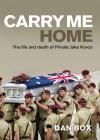Carry Me Home: The Life and Death of Private Jake Kovco
Written by: Dan Box,
Allen & Unwin, 2008, 288 pp
Reviewed by: Wing Commander Terence O’Connor
I approached the review of this book with a deep sense of foreboding having read Geoffrey Robertson QC’s reference to ‘institutionalised dickheadery’ in the publicity release. I had expectations of yet another ‘public flogging’ of the integrity and competency of the ADF. Having regard to what occurred during and after the repatriation of Private Jake Kovco, who could really blame any author who succumbed to the temptation to indulge in a little sensationalism.
I was therefore most pleasantly surprised to find that this book assiduously avoids that temptation and, instead, embarks upon a compassionate examination of the human dimension of the Kovco story. Box reveals the Kovco story in a compartmentalised fashion. Firstly, with a lengthy exploration of Kovco’s early life in rural Victoria and his early years in the Australian Regular Army. Kovco is revealed as a typical Australian male with a touch of the larrikin but always his own man. He was a good soldier who had found a second home in the Army.
The second part deals with Kovco’s death in Iraq and its immediate aftermath. The final part deals with the Military Board of Inquiry and the subsequent Civil Coronial Hearing.
Box has interviewed all of the key players in the Kovco story and presents their individual roles in the overall saga in a narrative with little comment or embellishment. He thereby provides to the reader the perspective of the individual decisionmakers along the way and brings an appreciation of the dilemmas facing the individuals who had to make decisions in unfamiliar circumstances. The decision to clean Kovco’s room after the incident; the performance of the Military Police sent from Australia to investigate the incident; the decision to repatriate Kovco’s body by private carrier; the failure of Kovco’s escort to properly identify his body before its final dispatch to Australia; the response of the politicians, especially the Minister for Defence, to the delivery of the wrong body; and the misplaced Cosson report are dealt with in a direct and dispassionate manner, allowing the reader to form their own view as to whether these incidents were the results of individual or systemic incompetence or understandable human failure.
Box’s treatment of the ADF Board of Inquiry (BOI) and the subsequent civilian Inquest occupied a relatively small portion of the book. It is in his treatment of the BOI that Box sometimes drifts into ill-informed comment. In particular, his suggestion that Kovco’s parents had little confidence in the outcome of the BOI from the outset believing that it would be a ‘white-wash’, a perception exacerbated by the innuendo that the BOI was vulnerable to Command influence, unfairly demeans the integrity of the legal personnel involved.
Fortunately, Box kept such comments to the margins and concentrated, as he should have, on the development of the complex issues before the BOI; that is, was Kovco’s fatal wound self-inflicted and, if so, was it by intent or by accident? Some of the evidence before the BOI emerged in quite sensational fashion. It was not only the military police who were baffled by the circumstances of Kovco’s death, also mystified were the hard men of the New South Wales Police Force who were called in to investigate it. The BOI was faced with some extraordinary factual hypotheses in a highly emotionally charged atmosphere.
It was Judy Kovco’s dissatisfaction with the findings of the BOI which led to the subsequent civilian Coronial Inquiry. Although this second hearing brought out additional sensational evidence not canvassed at the BOI, it came to a similar conclusion to that of the BOI. From a legal perspective, both outcomes could perhaps be criticised for containing too much speculation. However, there was considerable pressure on both the BOI and the New South Wales Coroner to make specific findings rather than an open finding (which may have been more appropriate).
One intriguing aspect of both hearings was that there was no medical evidence adduced in connection with Kovco’s mental state. In particular, there was no reference in the evidence that Kovco had been sexually molested as a child nor any evidence of the incident with the rifle (evidence which Box gave great prominence in his prologue). I can only assume that this information was not provided to either Counsel Assisting the respective Inquiries.
Box concludes the Kovco saga in the best possible way: by reference to his name being inscribed in the courtyard walls of the Australian War Museum alongside the many others who have lost their lives in the service of their country. That fact should never be forgotten.

